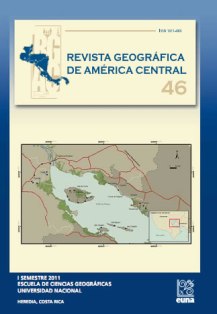INTEGRACIÓN ESPACIAL Y ESPECTRAL DE IMÁGENES FOTOGRÁFICAS: EL CASO DE OROSI, PARAÍSO, CARTAGO – COSTA RICA
Keywords:
Sensores remotos, imágenes fotográficas, imágenes multiespectrales, resolución espacial, resolución espectral. Remote sensing, photographic images, multispectral images, spatial resolution, spec- tral resolutionAbstract
Los sensores remotos proveen imágenes que según sus características permiten determinar cambios en el uso de la tierra. Se han desarrollado sensores con alto potencial para llevar a cabo este tipo de trabajo, aunque en ocasiones es difícil tener todos los elementos para discriminar los objetos en una misma imagen, por ello recurrimos a transformaciones para la consecución de los objetivos.
Este artículo constituye un subproducto del proyecto “Análisis de los cambios del uso de la tierra en el distrito de Orosi, utilizando datos teledetectados de los proyectos CENIGA1 (TERRA 97) y CARTA2
2003: período 1997-2003”. En el caso de Carta 2003 y Spot se presenta una coincidencia temporal pero no espacial ni espectral. El objetivo es ofrecer técnicas de transformación de imágenes fotográficas y multiespectrales del proyecto Carta 2003, así como una imagen de la plataforma del Spot. Las transformaciones de las imágenes permitieron cambiar la resolución espacial y espectral, las cuales variaban de 2 a 30 metros espacialmente y de 1 a 50 en su espectro.
Para los objetivos de la investigación se seleccionaron 9 bandas a las cuales fue posible aplicarles las transformaciones. Se obtuvo resultante de 2 metros de resolución espacial y 9 bandas espectrales. Utilizando las resultantes se realizó la clasificación supervisada, con lo cual se obtuvo un mayor nivel de detalle en la delimitación de los diferentes usos presentes en el área de estudio.
ABSTRACT
Remote sensors supply images that, according to their characteristics, allow for determining changes in land use. Sensors have been developed with a high potential to carry out this type of work, although on occasion it is difficult to have all of the elements to distinguish the objects in the same image, and for that we resort to transformations to attain the objectives. This article constitutes a byproduct of the project: “Analysis of Land Use Changes in the District of Orosi, Using Remote Sensing Data of the Projects CENIGA (TERRA 97) and CARTA 2003: Period 1997-2003”. CARTA 2003 and Spot present temporary coincidence but not spatial or spectral. The objective is to offer techniques of transforming photographic images and multispectrals of the CARTA 2003 project, such as an image of the Spot platform. Transformation of the images allowed for changing the spatial and spectral resolution, which varied from 2 to 30 meters spatially and from 1 to 50 in their spectrum. For the objectives of the investigation, nine bands were selected to which it was possible to apply the transformations, and with them managed to obtain results of 2 meters of spatial resolution and 9 spectral bands. Utilizing the results, the supervised classification was realized, obtaining a greater level of detail in defining the different uses present in the area of study.
Downloads
How to Cite
Issue
Section
License
Proposed policy for journals offering Open Access
Authors publishing their works in the Journal acknowledge and agree to the following terms:
a) Authors retain the copyrights to their works and guarantee the Journal the right to be the first to publish their works, under the Creative Commons License Attribution-NonCommercial-ShareAlike 4.0 International, CC BY-NC-SA 4.0 International (https://creativecommons.org/licenses/by-nc-sa/4.0/deed.es), which allows others to share works upon complying with the acknowledgment of authorship and mention of the Journal as the original publisher of the work.
b) Authors are permitted to separately establish additional agreements for the non-exclusive distribution of the official edition of the work published in the Journal (for example, authors may desire to place the work in an institutional repository or incorporate it into a book that is to published elsewhere) so long they acknowledgment to recognize the Journal as the original publisher. The aforementioned additional agreements must respect the terms of the non-profit character and sharing philosophy of the original license (CC BY-NC-SA 4.0 International, https://creativecommons.org/licenses/by-nc-sa/4.0/deed.es).
c) Authors are encouraged to archive the post-print or editor/PDF version in Open Access repositories.






 REVGEO is licensed under https://creativecommons.org/licenses/by-nc-sa/4.0/deed.es
REVGEO is licensed under https://creativecommons.org/licenses/by-nc-sa/4.0/deed.es
.svg_4.png)

_(1).png)
_(1)_(1)_(1)_1.png)
(2)(1)(1)(1).png)
